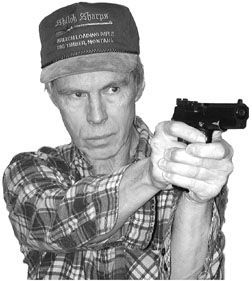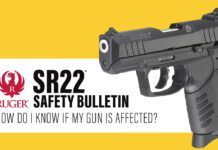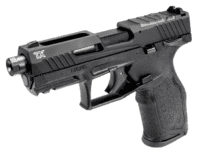
We all know 1911-type .45 autos are fun to shoot. Only thing is, ammo ain’t exactly cheap, even if you buy surplus or reload. But there’s a good way to get inexpensive 1911 shooting, and that is to buy a conversion unit to turn your 1911 .45 auto into a .22. However, we found yet one more way to get low-cost shooting with a 1911, and that’s to buy a 1911 set up to shoot nothing but .22 LRs. Kimber makes such a pistol, called the Rimfire Target ($775). We got one, and also acquired two .22 LR conversions for 1911s, by Marvel ($280) and Ciener ($250). We had a lot of fun with these, and this is what we found.
[PDFCAP(1)]
This Kimber was a .22 LR pistol in a full-size 1911 design, your choice of black or silver finish for the same price. It came with two 10-shot polymer magazines that we found to be perfectly reliable and the easiest to load of any magazines in this test. Those who think they need metal magazines please take note of that. Kimber also makes .22 and .17 rimfire conversions for your 1911, with a price tag of $305. The website (<www.kimberamerica.com>) has details.
Our test Kimber pistol was exactly the same size as a normal 1911, but because it had an aluminum-alloy frame and slide, it was a good deal lighter than any full-size .45 we’ve seen. As such, it was too light, we thought, for serious NRA-type target work, and there was no apparent way to easily add weight. But that doesn’t mean we didn’t like it.
The overall appearance was attractive, with a matte-silver finish set off by comfortable black rubber grips. The slide was serrated in two places, at the back for normal chambering and at the front for press checking. Both sets of serrations were easily used, yet did not cut the fingers. All the controls were identical to those of a normal 1911 .45 auto, and had the same overall feel. The blued-steel sights gave an excellent sight picture. The rear was a Bo-Mar type, fully adjustable, and the front was securely dovetailed into the slide, though not pinned. The front sight was a Patridge form with a slightly rear-sloped rear face. This made holster work a bit of a problem, depending on the holster. The front of the slide and frame were beveled for easy holstering, but the bottom edge of the slide was sharp, and the ejection port could have used some softening, we thought. The trigger was a crisp and clean delight that broke at 4.5 pounds. It had an adjustment for overtravel.
The slide did not stay open after the last shot, nor did any of the slides with these conversions. Various reasons were given. We didn’t find it a problem. Workmanship on the gun was excellent, we thought. The fit and finish were without flaw. The slide was adequately tight to the frame. Takedown is identical to that of a normal .45 1911, but the parts inside are different. In fact, though the frame looked to be a standard .45-auto frame, we could not fit the slide of our Norinco onto it. (The Ciener unit went right on, though.) The .22 Kimber’s barrel didn’t have locking lugs. It was blowback in operation. The workmanship inside was also a delight to the eye, being well done and well finished.
On the range we liked the Kimber even more. It shot very well with everything, had zero problems except when we tried Federal high-speed ammo (which Marvel said wouldn’t work in its conversion). This failed to eject, just as it did with the other two conversions. That’s not to dismiss the otherwise fine Federal ammunition. It just didn’t work here. The Kimber’s best accuracy was with Speer’s SGB lead flat-point bullet, which Kimber actually doesn’t recommend because of the bare-lead bullet. Yet it worked perfectly for us and gave the smallest (0.5 inch) five-shot group of this report. We tested everything with Speer SGB, CCI Mini Mags, and Remington High Velocity loads. The Kimber liked them all, and there were zero malfunctions. Overall accuracy we found to be hovering around the 1-inch mark for all our shooting with all ammo.
[PDFCAP(2)]
[PDFCAP(3)]
Ciener’s options with his pistol conversions are gloss black, matte black or silver finish, your choice, same price. If you don’t want adjustable sights, take $50 off the price shown above. One magazine came with the unit. Today’s Ciener mags hold 15 rounds, and for a modest price he will upgrade your lower-capacity Ciener magazines. The Ciener magazines are exceptionally well made of aluminum alloy with steel followers, and are easily disassembled for cleaning.
Ciener also makes a shorter-slide unit for Commanders and CCOs, with or without adjustable sights, at the same prices. Ciener also makes .22 conversions for several other handguns including the Browning High Power, Beretta 92, Taurus PT92, and Glock 17 & 19. And they are made for a few rifles as well. One of our favorite .22 rimfire conversions is on a Colt AR-15, which has worked perfectly for us. They are also made for the Mini 14 and AK47S. (Details: <www.22lrconversions.com>.) Ciener conversions come in fitted, durable plastic cases. Installing the Ciener unit on your 1911 is a breeze. Remove your .45 slide and barrel and put Ciener’s unit onto your frame. Stick in the slide stop and start shooting. It’s that easy.
Our test unit was beautifully made and had a gloss-black finish. The slide serrations were crisp, worked well and felt good. Ciener’s front sight was integral with the aluminum-alloy slide. The sight blade had a serrated rear surface and was sloped forward to ease holster exit. The adjustable rear was an Eliason, set well down into the serrated top surface of the slightly raised top rib. The front of the slide was too sharp for best holster life, we thought, and the rear of the ejection port was too sharp for practicing stovepipe drills. The insides of the aluminum slide were well machined, as was the matte-finished steel barrel.
We installed the Ciener unit onto the frame of our Don Fisher-tuned Norinco 1911, which has a clean 4.5-pound trigger and 20-lpi checkering. It fit easily and well, but we felt a drag to the slide. The drag came from the hammer rubbing firmly against the bottom of the slide. When we first tried the unit on the range, the slide was reluctant to return to battery. We thought the Ciener conversion could have used a slightly stronger spring. Despite our initial problems we gave the Ciener unit a pass because: a) the test frame had been modified on its rails and hammer, and those modifications may have contributed to the stickiness; and b) the stickiness tended to diminish with more shooting. We felt that within a few hundred shots the slide would always go fully back to battery without any help. In fact it did so for most of our shooting. Still, we thought the unit could have used a stronger slide-return spring, which might have eliminated the problem. At about that time we noticed the unit was bone dry. There was no lubrication evident on it anywhere. A few drops of oil and the unit proceeded to function without fail, during our limited testing.
Even when the slide failed to return to battery (which we overcame by barely touching the slide with a finger), the Ciener unit never failed to feed, fire, and eject perfectly. It produced excellent accuracy with two of the brands of ammunition, and actually did better with those than the Marvel conversion. We liked the precision of this unit, its ease of installation, and the clean workmanship of the Ciener unit. We liked the magazine too, particularly when we found it loaded its 15 shots easily, and worked perfectly.
[PDFCAP(4)]
The Marvel’s slide was matte black, and was finished in a very tasteful manner, with attractive angular cuts on the slide and innovative “matting” to the top of the slide. The sights were adjustable, via a Bo-Mar-style rear. The steel front sight slipped into a longitudinal slot and was retained with a small screw. The front sight lent itself well to holster use, but the rest of the slide did not. The front edges of the slide were even sharper than Ciener’s, as were the edges of the huge ejection port. The front edges of the rear sight were also daggers waiting to cut you. The slide serrations were not as easily used as the sharper Ciener serrations, but were adequate. The innards of the slide were again well made and well finished, we thought (<www.marvelprecision.com>).
Installing the Marvel Practical unit onto our Fisher-modified Norinco frame required the use of a small wrench that came with the kit. One slips the slide onto his chosen frame and puts the special slide stop through the frame hole. Then the shooter presses back slightly on the slide and tightens the slide-spring guide against the slide stop with the supplied wrench. It’s only a hair slower than installing the Ciener unit, we found.
The Marvel went easily onto our test gun and, unlike the Ciener, onto all the other 1911 frames available, including the CCO. We noticed the magazine seemed to be a poor fit, rattling up and down nearly a sixteenth of an inch in the Norinco frame. It had similar but slightly less motion in the other 1911 frames on hand. Would that affect feeding? We took the gun to the range and loaded the ten-round magazine. At least, we tried to. Our first efforts hurt our fingers and we could not get more than nine rounds into the all-steel magazine. They were reluctant to fall into place despite vigorous use of the “helper” button on the spring. We eventually succeeded in getting ten rounds into the magazine, but it was a huge struggle. Those who insist on steel magazines take note. We’d rather load ten Kimber or Ciener magazines than one of the Marvel’s all-steel mags. We could easily load two of the others in the time it took to load one of the Marvel mags.
Though the manufacturer stated clearly, “Do not use Federal ammunition,” we tried it to see what was the problem. Federal Classic High-Velocity 40-grain copper-plated ammo would not cycle the slide. Fired cases stayed in the chamber. With the gun fully loaded with recommended CCI MiniMags, we began our accuracy testing. All went well until round seven, which failed to go fully home. The bullet was bent in the cartridge, trying to go into the chamber. The results made us think the magazine was resting too low, and we remembered the looseness of the magazine. The second magazine-load did the same thing on round seven, i.e., with the magazine nearly empty. Subsequent testing in other guns did not show any problems. Although the Norinco had fed perfectly from Ciener’s magazine, we concluded the Norinco’s magazine stop was a touch too low for the Marvel unit. When we tried the Marvel unit in other frames, none of them gave feeding failures during our limited testing. If we owned the Marvel conversion unit we’d change the magazine button on the Norinco. A Colt button held the magazine a touch higher, and worked perfectly within our limited testing. Bottom line, we concluded those failures to feed were caused by the frame, not the conversion unit, but we’d still like a tighter magazine fit.
Gun Tests Recommends
• Kimber Rimfire Target .22 LR, $775. Buy It. We thought the Kimber was an outstanding pistol. We liked it a lot, and highly recommend it for those who like the 1911. If you know your 1911, there’s nothing to learn with the Kimber. Just buy it and shoot the dickens out of it, which will get you low-cost but great 1911 handling practice than transfers to your .45. This lightweight gun would be a great outdoorsman’s tool, we thought. We’d love to have one, and for a street price of around $600, we just might make that happen.
• Ciener Platinum Cup Conversion .22 LR, $250. Buy It. The Ciener unit worked well, but fit only one of our on-hand 1911s. We tried installing this Ciener Platinum Cup unit — which is supposed to incorporate a bit more accuracy than the fixed-sight version, and may thus have tighter tolerances — onto three other 1911s. The Ciener did not fit on a slightly rail-modified 1991 Colt (rails too tight), did not fit our Valtro (rails too tight, though the Valtro is entirely standard, though Italian-made), nor did it fit a CCO (ejector too wide). The CCO and Valtro were, we thought, standard 1911 configuration. We mention this because the Marvel unit worked on all four of those 1911s. However, the Ciener unit slipped onto the frame of the Kimber Rimfire Target like it’d been made to fit it, and worked like a dream with that frame. So we can’t fault the Ciener for not working with guns it’s maybe not supposed to work with.
• Marvel 1911-.22 Practical Conversion .22 LR, $280. Our Pick. Accuracy was excellent with CCI, okay with Speer’s SGB, and not so good with Remington, which averaged close to three inches. As noted, we tried the Marvel unit on our other available 1911s and found it fit them all, which made this unit our preferred choice. Our favorite setup was on the Colt CCO, even though the magazine stuck out the bottom of the frame. We are partial to the CCO, and its light-alloy frame made the conversion feel much like the Kimber Rimfire Target. The CCO performed perfectly with the Marvel setup, as did the Valtro and a Colt 1991. Our conclusion is if you have a gun that might not be fully compatible with original 1911 specs because of rail modifications, etc., the Marvel will probably fit and work in more cases than the Ciener unit. We liked this unit for that versatility.





























